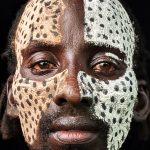The Suri Tribe
January 13, 2022
Today, there are some 60,000 suri people in the south western Omo region of Ethiopia, primarily to the west of the Kibbish River and in the southern part of the Tulge valley. They speak a Surmic language belonging to the Nilo-Sahara language family, share a common language, and often intermarry the Mursi (Muni) who live east of the Omo River.
According to Suri oral tradition, they arrived in their current region around Mount Naita about 200 years ago from southern Sudan. First they come to Akobo. The Meyun clan (part of the Suri at the time) then moved south to settle at Boma, while the remaining Suri crossed the border and settled at Koma.
The majority of the population lives in the semi-arid savannah of the Kibbish River valley. They are pastoralists, who also practice subsistence farming. Their main crops are maize and sorghum, with some beans, cassava, and greens as well. They have two harvests annually, the first being in June-july and the second being in October-November. The stick fighting season begins with the first harvest and lasts until November. During this time, there is plenty of food and beer available to give nourishment to the stick fighters and spectators. In fact, most ritual celebrations are held during this time of year because there is sufficient food (e.g., weddings, the celebration of an elderly person’s death, and age-grade promotions). In the months of January-February,
Livestock is incredibly significant to the Suri people, economically, socially, and symbolically. It is possible to claim that the Suri or Mursi heritage and fabric are constructed around their cattle. Cattle are praised, ornamented, and exalted to the point where they are given names based on the colour and pattern of their favourite cows. Here, men are required to pay up to 60 cows plus an AK-47 rifle dowry and, at times, put their lives in danger to safeguard their herd and raiding livestock from local tribes.
They have a strong aesthetic sense that centers around the awareness of color, body scarification, and body painting. Adorning themselves with intricate floral headdresses and striking face and body painting , larger pottery lip plates (which represent female social adulthood), and ceremonial duelling (annual stick fighting ) are a few of the distinctive features of the Suri community.
The Suri have a traditional religious system that includes a supreme sky god named Tumu. The komoru serves as a mediator between humans and the Tumu, functioning as a point of communication with the sky deity who gives rain and fertility. However, Suri has no public religious rites devoted to Tumu. Clan ancestors are also considered to possess abilities and impact the health and fate of living individuals.



